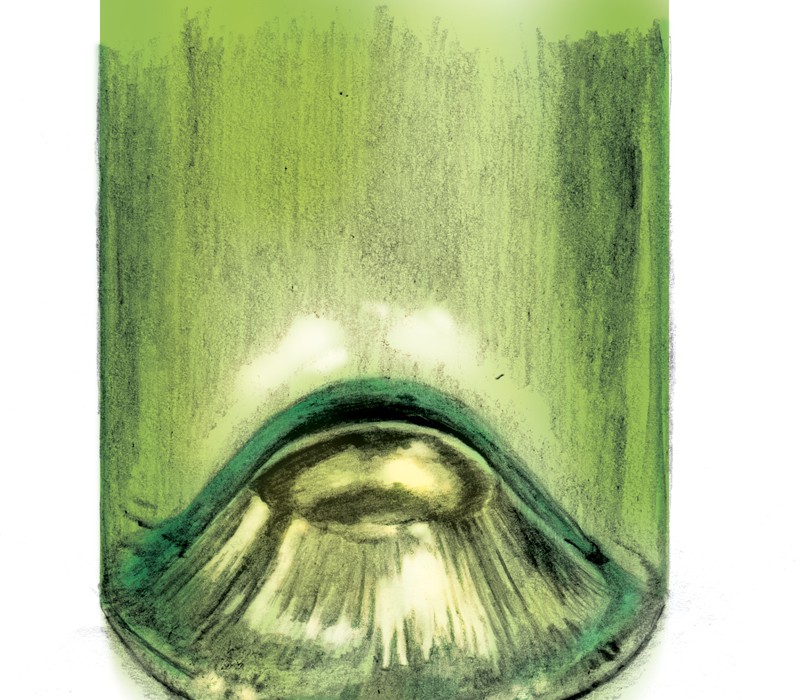By Mugroso
Not long after your arrival to Oregon wine country, you’ll hear someone reference the local AVAs as American Burgundy. To the casual observer, guzzler, or sipper alike, such a reference may be lost. A visiting French tourist might dismiss the mauvaise idée ridicule out of hand. But in our local wine industry, the suggestion of Oregon pinot noir as the global peer to vin bourgogne has never before been more compelling.
Why?
The French and their greatest most heralded wine artisans have never before taken such a keen interest and investment in our local vineyards and winery operations.
Oregon’s pinot pioneers—the late David Lett of Eyrie in 1965, and David Adelsheim in 1975, among others—began planting Burgundy’s prized grape varietal, pinot noir, in and around Dundee. Some, like the late Archery Summit founder Gary Andrus, smuggled so-called “suitcase clones” back to Oregon from cuttings of famous Burgundian sites like La Tache. But this is history, and well-documented.
When pressed as to why our wine country would draw comparisons to France’s great pinot and chardonnay regions today, inevitably it is suggested that it is the latitude of Oregon that compares to Burgundy, or the climate and cooler growing seasons that embrace the temperamental pinot noir grape. There is something to be said for each of these influences, but there also are differences. The French would kill for our dry summers, which allow Oregon pinot producers to avoid the disease and mildew challenges found in Burgundian vineyards. But if you prefer delicate and elegant from your pinot, perhaps you would wish for the limestone terroir and minerality of Burgundy rather than the volcanic soils of our region.
In 1976, California wines made an entrance onto the global fine wine stage by winning the now-famous Spurrier Competition in France for chardonnay and cabernet sauvignon. Just three years later, Lett’s 1975 pinot noir won back-to-back pinot noir competitions in Paris and Beaune. Oregon pinot noir has been in the spotlight ever since.
Since that spotlight event in France, Oregon’s pinot pioneers have been joined by hundreds of newcomers to the region. Today, more and more of these newcomers arrive directly from the motherland of pinot: Burgundy.
Maison Joseph Drouhin’s Véronique Drouhin opened Domain Drouhin Oregon in 1988. Dominique Lafon, of Domaine de Comtes Lafon in Meursault, came to Oregon in 2007 to consult as winemaker for Evening Land Vineyards in Salem. (Today its Dundee tasting room is managed by the always engaging Sarah Torres.) Alexandrine Roy of Domaine Marc Roy works with Hood River’s Phelps Creek Vineyards.
To add further distinction to our Burgundian credentials, Oregon has been home to the International Pinot Noir Celebration since 1987, which attracts pinot lovers and craftspeople from around the globe.
Voilà! We have found Burgundy and it is us!
If we don’t consider Lett and his Pinot pioneer contemporaries as the first wave of Burgundy in Oregon—and we do not—certainly the days since Drouhin arrived have been considered the first wave of the Burgundy Invasion. Most recently we are knee-deep in Burgundy Invasion, Part Deux.
At the end of summer in 2013, the acclaimed Maison Louis Jadot came to Oregon armed with the considerable talents of internationally acclaimed winemaker Jacques Lardière. The same year, Louis-Michel Liger-Belair, of fabled Domaine du Comte Liger-Belair in Vosne-Romanée, came to Oregon to develop wines in concert with Evening Land’s former founder, Mark Tarlov. Labels such as Two Messengers, Fire + Flood, Horsetail, Arrouya, and Coattails are just finding their first entries into our marketplace.
Tongue-tied yet? Here’s another.
Celebrated Domaine Méo-Camuzet legend Jean-Nicolas Méo and former IRS Records and MCA Records mogul Jay Boberg joined forces to start a winemaking operation in Carlton in conjunction with Scott Paul Wines. Our Burgundian dance card is filling up fast!
Scott Paul Wines founder Scott Wright came to Oregon not from Burgundy but from California. There he made pinot noir (following a successful stint hosting a Top 40 and nationally syndicated radio show under the moniker Shadow Stevens). In 2001, Wright took over as Managing Director of Operations at Domaine Drouhin Oregon after starting his own label and winery in Carlton. In 2006, Scott Paul began a compatible operation as an importer of small family domaine Burgundies, and later small grower Champagnes. The various operations combined to meld the bouquets, flavors, and bottled experiences of pinot’s best, est et ouest.
“There’s really only two places on the planet that we know of that can make this kind of pinot noir with elegance and finesse: Oregon and Burgundy,” says Wright. “To make the kind of wine we wanted to make, we knew we had to be in Oregon.”
Of his collaboration with Méo and Boberg, Wright says he advised and pointed the new collaborators in the “Wright” directions, and, thanks to their small 2013 production, offered them the opportunity to produce their wine at his facility. The friends produced two small lots: one entirely in Jean-Nicolas’ Burgundian wine-making style and one from Kelley Fox, Scott Paul’s winemaker, and Wright himself. But the collaboration was short-lived. Tant pis!
“They are planning to grow quite a bit,” Wright says, “so we will not have the capacity to continue to produce their wine. It was a one-vintage experience. A special bottling.”
There are perhaps more collaborations with the French in the offing, however. Thanks to the import business, Wright contemplates bringing guest Burgundy winemakers over to make special labelings through Scott Paul Wines in the years to come.
“I spend six to eight weeks a year in Burgundy, tasting and visiting with the wineries we work with,” explains Wright. “I think the Burgundian producers have a great respect for the wines coming out of Oregon. There’s been a lot of interplay between the winemakers from both regions. A lot of cross-pollination. We hope to do some of that.
“Wine should be all about exploration and learning and understanding what makes the wine what it is. We’re just at the beginning [of making pinot] here in Oregon. But we’re catching up quick.”
Considering the high number of famous French domaines and winemakers arriving amid Burgundy Invasion – Part Deux, should we be worried about their buying up all the good wineries, such as those started by the Oregon pinot pioneers? Should the nice people of the Dundee Hills pick up a Rosetta Stone French Edition just in case?
“I wouldn’t be surprised if there is continued involvement by more Burgundy producers and winemakers,” says Wright. “They are constrained by vineyard availability in Burgundy and are looking for ways to branch out and make quality, cool-climate pinots.”
But an invasion and takeover? It is the French nature, Wright advises, that will keep them in check.
“They move kind of slow. Jadot thought about coming over here for 12 to15 years before finally making the leap last year. I wouldn’t be surprised to see some acquisitions. Are they going to come over here and buy up all of our great wineries and vineyards? I’m not too worried about that.”
Oregonington Selections of the Month:
2011 Penner-Ash Zena Crown Vineyard Pinot Noir, $60.
As previously suggested, the temperamental 2011 vintage may be a curse and a blessing. At Penner-Ash, the 2011 Zena Crown single vineyard designate pinot noir, borne of Eola-Amity Hills AVA fruit, is an inspired effort in a challenging vintage. In a recent “March Madness” 2011 vs. 2012 tasting at the winery, the 2011 ZC took the crown among the contenders. Penner-Ash describes it as “Aromas of black cherry, baking spice, and black pepper lead to a palate that is dense and concentrated, offering complex flavors of black currant, blackberry, sweet earth, tobacco, and black tea. Tannins are silky and balanced and taper to a fine, lengthy finish” that lingers far beyond the three-point line. Kudos, PA!
2012 Willakenzie Pinot Blanc, $21.
It’s never too early to think about summer: a nice afternoon with a soft breeze among the fir trees, a lovely lady in an airy white cotton dress…and a nice white wine. The 2012 Willakenzie Pinot Blanc is golden in hue and softly fruity on the nose, evoking essence of honeydew melon, Bosc pear, citrus, and green apple. Meyer lemon, apricot, almonds, and apples dance around the palate. A riper vintage, the 2012 promotes astute acidity, a creamy, thick texture, and a long finish that makes the warm afternoon linger just a bit longer. This Pinot Blanc will age for up to five years, but is delicious and drinkable now. Open one up on a warm day—and make sure there’s another in the fridge.

